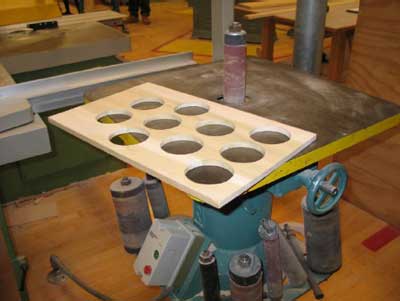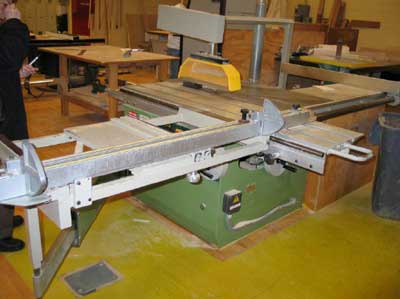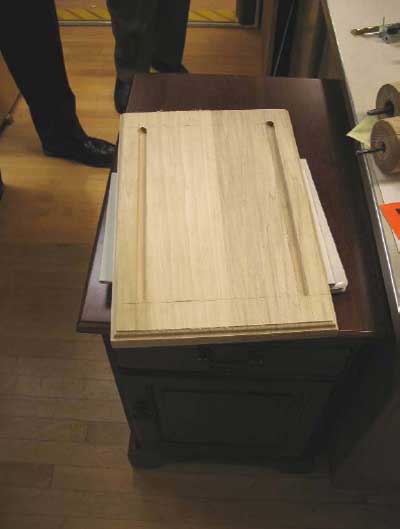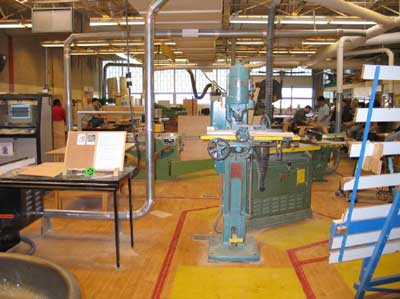Two 10th Grade Students Injured in Separate Incidents in the Same Mill/Carpentry Vocational School Shop - Massachusetts
Massachusetts Case Report: 06-MA-1NF
Release Date: July 9, 2007
Summary
In 2006, two 10th grade students in a Chapter 74 approved vocational technical education program were injured in two separate incidents, eight days apart, in the same mill/carpentry school shop. One of the two students was injured while operating a spindle sander when the wood piece being sanded started to rotate uncontrollably with the sander’s spindle. The wood piece injured both hands of the student. After the incident the student went to the school nurse’s office where a call was placed to the student’s mother who came to the school and drove the student to the hospital. The second student was injured eight days later when the student’s hand came in contact with the rotating blade of the table saw the student was operating. The student had just finished making a cross cut on a wood piece at the time of the incident. After the incident the instructor called the school nurse for help. A call was placed for Emergency Medical Services (EMS), which responded and was at the incident site within minutes. EMS transported the student via ambulance to a local hospital. The Massachusetts Department of Public Health concluded that to prevent similar occurrences in the future, schools with mill/carpentry shops should:
- Provide shop conditions that at a minimum meet occupational safety and health standards set by the Occupational Safety and Health Administration (OSHA), and train students about these standards;
- Ensure that the machine guarding used is the most effective guarding available;
- Ensure that the appropriate equipment/tool is matched to the task being performed;
- Ensure that students are comfortable operating equipment before being allowed to operate the equipment without direct supervision;
- Design shop layouts to minimize potential distractions to equipment operators;
- Routinely review shop lesson plans to include up-to-date information;
- Ensure that student/teacher ratios in shop classes are within the recommended and/or required ratio guidelines issued by departments of education.
Introduction
The Occupational Health Surveillance Program at Massachusetts Department of Public Health conducted an investigation of these incidents, visiting the school site and talking to school staff about these incidents.
The injured students were attending a Chapter 74 approved regional vocational technical high school and were enrolled in the mill/carpentry shop. The school consists of grades nine through 12 and has 16 vocational technical programs with more than 1,300 students enrolled. The mill/carpentry shop was designed to provide students with the skills to work in the building trade industry. Students enrolled in this shop learn various skills such as setting up and operating shop equipment, constructing wood cabinets/furniture, and blueprint reading. The shop also has a house building project where juniors and seniors are instructed in rough framing techniques, shingling, and exterior and interior finishes.
The school follows a schedule of two weeks in shop and two weeks in academic classes. During shop weeks, students are required to take shop specific related-theory classes. As freshmen, the students are shown how to operate the equipment in the shop. A checklist of all 15 machines in the shop is used to provide a record that each student has been shown how to operate each machine. Students watch the teacher operate a machine, and then each student demonstrates competency by operating the same machine with the teacher observing. Once students demonstrate that they can operate each machine as directed, the students are allowed to operate that machine without direct one-on one supervision. This process is repeated for all 15 machines located in the mill/carpentry shop. At the end of the freshman year, a 50 question written test that covers how to operate the various machines is given to the students. A teacher is always in the shop when the machines are being operated.
During the first two weeks of the sophomore year, the students’ shop time is spent reviewing the operation of each of the machines and then students demonstrate again to the teacher that they can operate the machines as they were shown. A 15 question test on the machines is also administered to the students, and once the students have passed this written exam they are again allowed to operate the machines without direct supervision. On the day of the site visit to the shop, the student teacher ratio was 19 students to one teacher. Of the 19 students present, ten were sophomores and nine were juniors.
In both of the incidents under investigation, the injured students were sophomores, had been through the above mentioned teaching procedure, and were operating woodworking machinery without direct one-on-one supervision.
Investigation
Incident #1
Incident #1 involved an oscillating vertical stationary spindle sander with a one horse power motor. The spindle sander was equipped with a 24 inch square horizontal table and a sanding spindle that protruded vertically through the table (Figure #1). Spindle sanders are designed to create clean, scratch free finishes to wood pieces. Spindle sanders are typically used to sand convex and concave surfaces, irregular curves and difficult to reach locations. Sanding with the spindle sander is typically performed by the operator using their hands to hold onto the wood piece during sanding, but a jig, a device used to maintain the correct positional relationship between the wood piece and the spindle, can be used to increase sanding accuracy and stability. Multiple diameter spindles are available and the size of the spindle used depends on the task.
On the day of incident #1, the student was working with a wood piece that contained multiple round holes (Figure #2). The wood piece was part of the student’s project, which was to build a wine rack. At the time of the incident, the student was operating the spindle sander with a two inch diameter spindle to sand the interior edges of the round holes in the wood piece. During the sanding task, when the spindle was inside one of the holes and rotating, the student lost control of the wood piece when it started to rotate with the spindle. The rotating wood piece struck the student’s hands. The student went to the school nurse’s office, and a call was placed to the student’s mother. The student was picked up at school by the mother and transported to a local hospital. The student had two fractured fingers on the left hand and cuts on the right wrist and thumb from the incident. The student missed two weeks of school after the incident.
Incident #2
Incident #2 involved a table saw with a nine horse power motor and a five foot sliding table (Figure #3). Table saws with sliding tables tend to be easier to handle and can provide a more accurate and precise cut than table saws without sliding tables. The sliding table is used to manually feed the wood into the rotating blade of the saw. Once the wood piece is positioned on the sliding table, the operator pushes/walks with the sliding table until the cut is completed.
On the day of incident #2, the student was working with a wood piece that measured 11 inches wide x 16 inches long x 1 ½ inches thick (Figure #4). The wood piece was part of the student’s project to build an occasional table. The student had made a cross cut to shorten the wood piece to the required length for the project. After the student finished the cross cut, the student reached either to remove the piece of wood that was cut off, or to grab the wood piece to rotate it and prepare for the next cut when the student’s hand came in contact with the rotating saw blade. Immediately after the incident, the school nurse was called to the shop and then emergency medical services (EMS) were called. EMS arrived at the shop within minutes and transported the student to a local hospital. The student received 32 stitches in the right hand.
Recommendations/Discussion
Recommendation #1: Schools with mill/carpentry shops should provide shop conditions that, at a minimum, meet occupational safety and health standards set by the Occupational Safety and Health Administration (OSHA), and train students about these standards.
Discussion: Chapter 74 approved vocational technical education programs provide students with important opportunities to learn technical skills and to introduce them to various work environments. Occupational safety and health is a crucial component of work preparation, both to ensure safety in the school shop and to develop safe work skills for the future. Schools are required by the Massachusetts Board of Education to provide environments that, at a minimum, meet safety and health standards set by the Occupational Safety and Health Administration (OSHA) and to train students about these standards (603 CMR 4.03) and on hazard recognition.
The OSHA standard for woodworking machinery (29 CFR 1910.213) states that when using a circular hand-fed table saw to make a crosscut, the saw shall be guarded by a hood which shall completely enclose that portion of the saw above the table and that portion of the saw above the wood piece being cut. The hood and mounting shall be arranged so that the hood will automatically adjust itself to the thickness of and remain in contact with the wood piece being cut. The guard that was being used on the table saw at the time of incident #2 did not completely enclose the portion of the blade that was above the saw’s table and was not an automatically adjusting guard.
In addition to the hood guard when crosscutting, the OSHA standard for woodworking machinery (29 CFR 1910.213) states that when using a circular hand-fed table saw to make a rip cut, the saw shall be furnished with a spreader to prevent material from squeezing the saw or being thrown back on the operator and anti-kickback fingers (or dogs) to prevent the wood piece being cut from being thrown back toward the operator. Although at the time of the incident involving the table saw the student was not ripping a wood piece, the saw was equipped with a spreader but was not equipped with anti-kickback fingers.
The National Institute for Occupational Safety and Health (NIOSH) has developed a Safety Checklist Program for Schools. This checklist was designed to help schools comply with and/or follow federal or state OSHA regulations. The checklist document has been divided into four chapters:
- Chapter 1: Making Sense of Regulations. This chapter provides background information concerning the regulatory agencies and regulations that are applicable to career-technical education.
- Chapter 2: How to Establish an Effective Occupational Safety and Health and Environmental Safety Program. This chapter outlines ways to ensure that an effective program is instituted and maintained.
- Chapter 3: Implementing a Safety Checklist Program. This chapter describes how to implement a checklist program in your school to identify hazards and determine regulatory compliance. Special indexes listing the checklists by name, career-technical program, and hazard will help select which checklists to use for each career-technical course or program. This chapter also provides a case study of a real school’s checklist program. Handouts are included for teacher training in the use of the checklists.
- Chapter 4: Safety Checklists. This chapter contains all of the checklists.
The NIOSH Safety Checklist Program for Schools and be found on the NIOSH Web site at www.cdc.gov/niosh/docs/2004-101/default.html.
Recommendation #2: Schools with mill/carpentry shops should ensure that the machine guarding used is the most effective guarding available.
Discussion: As discussed, in the incident involving the table saw (incident #2), the saw was equipped with a manually controlled blade guard/dust hood that did not meet the requirements of the current OSHA standard 29 CFR 1910.213. The blade guard/dust hood was bulky and made of plastic; only one side was a clear plastic, the other sides of the guard were an opaque yellow plastic (Figure #3). The blade guard/dust hood required the saw operator to manually adjust the guard for each cut. Although the saw was not being operated at the time of the site visit, the blade guard/dust hood was in the up position and was not covering the saw blade.
This blade guard/dust hood was designed to accomplish two functions: 1) to protect the saw operator and others from the rotating saw blade; and 2) to function as a hood to collect wood dust generated during the cutting process as part of the dust collection system. The dust collection function of the blade guard/dust hood was no longer in use at the time of the incident and during the site visit. The school had installed a down draft dust collection system on the table saw. Therefore, the equipment was being used for one of the two functions for which it was designed. Retrofitted guards for table saw blades that meet the requirements of the current OSHA standard are available.
Had the guard been designed for the sole purpose of reducing the chance that the saw operator would come in contact with the rotating saw blade, the guard’s design might have offered a higher level of protection that would include features such as:
- automatically adjusting to the wood piece thickness, as required by OSHA, to keep the guard in constant contact with the wood piece being cut which would keep the blade covered at all times;
- smaller size to be less bulky;
- increased visibility of the point of operation by using clear plastic for the entire portion of the guard covering the blade
Although the spindle sander’s unguarded spindle did not contribute to the injury the student sustained while operating the spindle sander (Incident #1), the unused top section of the rotating spindle sander should be guarded to prevent items such as the operator’s hair and clothing from becoming entangled in the rotating spindle. Retrofitted guards for the spindle sander are also readily available.
Recommendation #3: Schools with mill/carpentry shops should ensure that the appropriate equipment/tool is matched to the task being performed.
Discussion: The size of the spindle to be used for a task should be based on the wood piece to be sanded. Larger spindles should be used only when sanding straight or gently curved surfaces. Smaller diameter spindles are best suited for wood pieces with tighter curves and/or more intricate details.
In the incident involving the spindle sander, the injured student was sanding the interior edges of the round holes in the wood piece with a two inch spindle (Figure #2). If the student had been using a smaller diameter spindle, the area between the wood piece and the spindle would had been increased and would have reduced the continuous contact between the wood piece and spindle that most likely contributed to the student losing control of the wood piece.
A hand held spindle sander might be a better piece of equipment to use when sanding the interior edges of holes in a wood piece. Use of a hand held sander would allow the wood piece to be clamped to a workbench during the sanding task, reducing the possibility of the wood piece rotating out of control.
Recommendation #4: Schools with mill/carpentry shops should ensure that students are comfortable operating equipment before being allowed to operate the equipment without direct supervision.
Discussion: It was reported that the student who was injured operating the spindle sander (Incident #1) did not feel comfortable operating any of the shop equipment. At the time of the site visit, the student injured while operating the table saw (Incident #2) stated that they did not feel comfortable operating the saw at the time of the incident.
Students are allowed to operate equipment without direct one-on-one supervision once they have watched the teacher operate a machine and then have demonstrated competency by operating the same machine with the teacher observing. The “show-one do-one” teaching method may not ensure that individuals, including teenagers and adults, know how to operate a piece of equipment and feel comfortable operating the machine. In some cases, smaller teens may be physically mismatched for equipment that has been designed for adult males. Teenagers tend to have limited experience with operating equipment, and in their desire to demonstrate independence, they may be hesitant to speak up about their concerns. Therefore, teenagers may require additional time, attention and different approaches to training than that which is effective for adults.
Teachers should ensure that each student feels comfortable operating a machine before allowing the student to operate the machine without direct supervision. Steps to assess comfort level could be built into the standard protocols for assessing student competency. The protocols could be modified to include directly asking the students exactly how comfortable they feel operating the equipment and to ensure that students can continue to have one-on-one supervision when operating equipment that they do not feel comfortable using.
Recommendation #5: Schools with mill/carpentry shops should design shop layouts to minimize potential distractions to equipment operators.
Discussion: Both the spindle sander and the table saw involved in these incidents were located near the shop’s door that lead to a hallway. Relocating or reorienting the equipment could reduce the possibility of the operators being distracted by individuals entering, exiting or walking by the shop. Rotating the spindle sander clockwise, so the operator would be facing a wall when operating the sander, might reduce operator distractions. Relocating the table saw closer to a wall away from the doorway and positioning it so the operator has the least amount of contact with the other students in the class could also reduce the possibility of the operator being distracted operating the equipment.
It appeared that the overall layout of the shop could be improved (Figure #5). The shop was divided into two sections by an office for the teachers. The location of the office created a U-shaped shop area. One side of the shop was setup and used as a classroom, and the other side of the shop is where all of the machines were located, which seemed tight for space. The entire shop layout should be reevaluated, and the possibility of moving or changing the shape of the teachers’ office to allow for more space for the machines should be given some consideration. Any redesign should maintain ability of the teacher to have all students in view while using equipment.
Recommendation #6: Schools with mill/carpentry shops should ensure that students have a shop lesson plan that includes up-to-date information.
Discussion: Owner’s manuals for the table saw and the spindle sander were available on site, but it appeared that they had not been utilized as a source of information on how to operate the equipment properly. The document that was in use at the time of the incidents and site visit was the Carpentry Manipulative Instructional Units For Mill Work, Unit IX. This document was developed by the United Brotherhood of Carpenters and Joiners of America in 1952. An updated document/training guide should be researched, sought and incorporated into the lesson plan for the students in the shop. This lesson plan should also utilize the manufacturers’ owners’ manuals for all equipment. Owners’ manuals are the ideal source of information for learning exactly how the manufacture intended the machine and equipment to be operated. The owners’ manuals also include information about safety features on machines. The NIOSH Safety Checklist Program for Schools discussed in Recommendation #1 is another good resource for incorporating health and safety into lesson plans.
Recommendation #7: Schools with mill/carpentry shops should ensure that student/teacher ratios in shop classes are within the recommended and/or required ratio guidelines issued by departments of education.
Discussion: The Massachusetts Board of Education currently has developed a recommended student/teacher ratio of 15 students to one teacher for carpentry shops. The shop involved in these incidents had a student/teacher ratio of approximately 20 students to one teacher during both incidents and during the site visit. Vocational schools should attempt to adhere to recommended student/teacher ratios in order to provide students with the supervision and attention needed in the shop setting.
References
- Protecting Youth at Work, American Journal of Industrial Medicine, 36:579-582 (1999), Wegman, Davis
- Code of Massachusetts Regulations. 603 CMR 4.03. Program Approval Criteria, Vocational Technical Education.
- ILO. Encyclopedia of Occupational Health and Safety, 4th Edition, Volume 3. Geneva, International Labor Office, 1998.
- Code of Federal Regulations. 29 CFR 1910.213. Machinery and Machine Guarding. Woodworking machinery requirements, Government Printing Office
- Code of Federal Regulations. 29 CFR 1910.219. Machinery and Machine Guarding. Mechanical power-transmission apparatus.
- U.S. Department of Labor, Occupational safety and Health Administration. A Guide for Protecting Workers from Woodworking Hazards. OSHA 3157. 1999.
- National Safety Council. Safeguarding Concepts Illustrated 6th Edition, 1995.
 |
 |
 |
 |
 |
|
Figure 5 – Mill/Carpentry shop
|
To contact Massachusetts State FACE program personnel regarding State-based FACE reports, please use information listed on the Contact Sheet on the NIOSH FACE web site Please contact In-house FACE program personnel regarding In-house FACE reports and to gain assistance when State-FACE program personnel cannot be reached.
